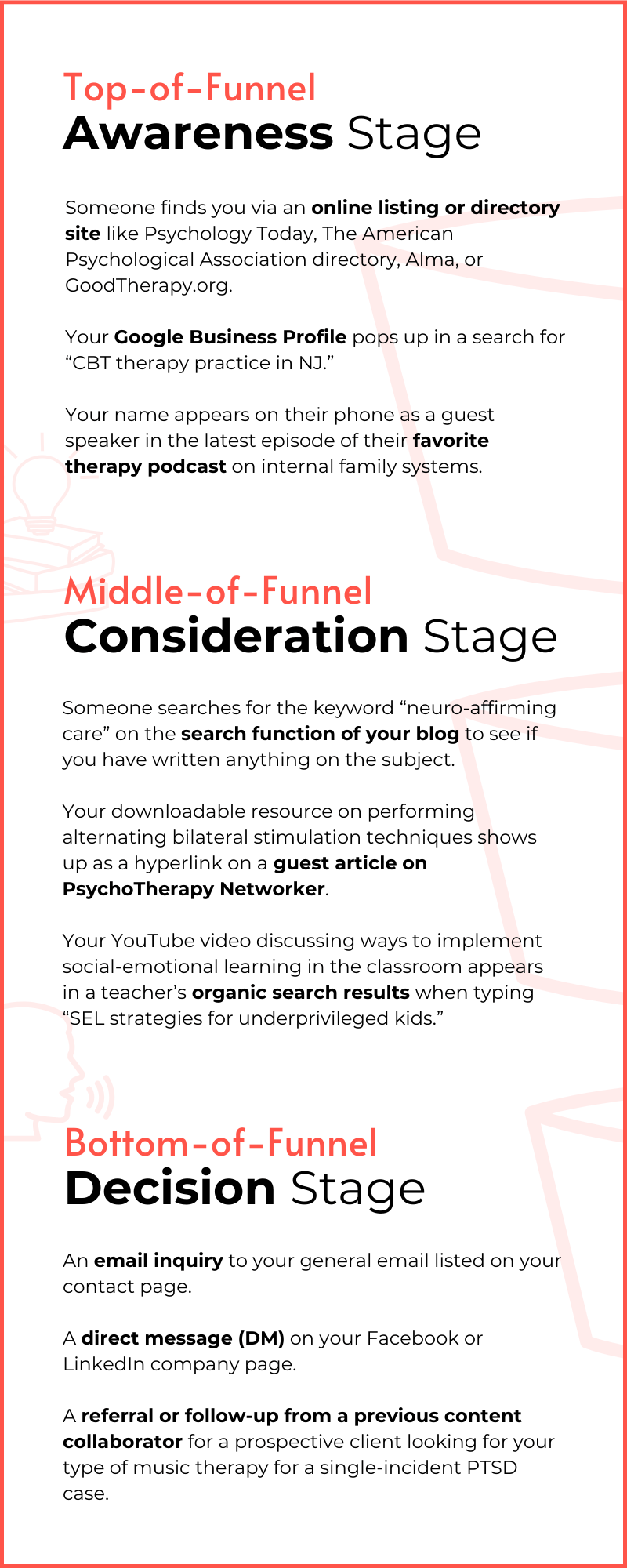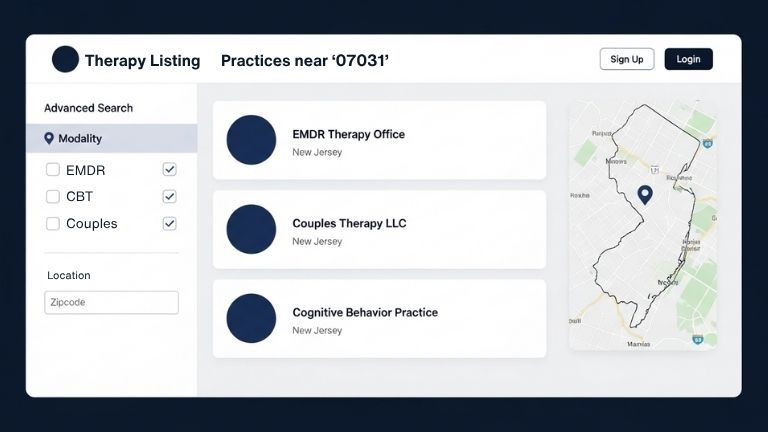Listen to this article:
Successfully marketing a private therapy practice requires an understanding of the marketing and sales funnel. This article introduces the power of funnel-based content to guide visitors from discovery to client and how to tailor your messaging to each stage of the journey. We’ll also review how to attract ideal clients, qualify leads, and scale your practice to adapt to changing online landscapes. You’ll learn what defines a lead, how your content can both invite and disqualify potential clients, and which core channels and strategies support long-term growth.
Table of Contents
- What is Funnel-Based Content for Therapists?
- What is a Lead in Therapy Marketing?
- Lead Qualification for Therapy Marketing
- Tactical Therapy Marketing 101: The Essentials
- Typical Client Search Behavior
- Common Misconceptions About Therapy Marketing
- Finding a Marketing Agency for Therapy Practices
Marketing your private therapy practice goes beyond social posts or a website. Your goal is to future-proof how you communicate your value to prospective clients. Funnel-based content marketing guides a prospective client’s decision-making process along the customer lifecycle, from initial interested visitor to signed client.
The content you create from funnel-based marketing is both scalable and reusable, shifting your marketing away from reactionary to adaptable in the face of economic downturns and spending slowdowns.
During the COVID-19 pandemic, your practice might have experienced a sharp rise in consultations resulting from the direct impact the virus had on individuals’ loved ones and their careers.
Now, your practice might be experiencing a decrease in the number of inquiries as a result of anticipated rises in U.S. cost-of-living, resulting in a curb in mental health spending as a cost-saving measure, as mentioned in a June 2025 IBISWorld market research report for mental health and substance abuse clinics in the U.S.
In this article, we’ll outline the marketing funnel for therapy practices as it pertains to the client lifecycle, and show how content plays a role in clients’ active decision-making processes. For therapists and clinicians brand new to the idea of marketing their private practice, we’ll define a “lead” and how lead qualification impacts how you market your client services, paid workshops, continuing education options, and consulting services.
What is Funnel-Based Content for Therapists?
According to the Semrush blog, a leading SEO marketing tool, the marketing and sales funnel is:
“…A model of the customer journey that shows how people move from discovering a brand or product to making purchases and becoming loyal advocates.”
The marketing and sales funnel has three primary stages:
- Awareness Stage
- Consideration Stage
- Decision Stage
Let’s walk through each stage.
Top-of-Funnel | Awareness Stage
- Prospective clients at this stage realize they have a problem or just need support. They’re not aware of any solutions or how to name their problem.
- Your online content should remain educational and avoid heavy clinical jargon. The goal is to help the visitor identify and name their challenge or problem.
- E.g. Blog article or a video defining trauma or common, maladaptive coping mechanisms.
Middle-of-Funnel | Consideration Stage
- Prospective clients have named their issue and are exploring different treatment methods.
- Your online content should outline your modality and client scope. Content here will help someone understand why your approach would be effective for them and what differentiates your approach from others.
- E.g. A worksheet with self-directed couples’ communication exercises, or a one-pager on the differences between EMDR and DBT treatment.
Bottom-of-Funnel | Decision Stage
- Prospective clients at this stage know what kind of therapy they seek, treatment options that fit their goals and needs, and are actively comparing providers.
- At this stage, your online content should clearly communicate your unique value, fees, insurance policies, and session logistics.
- E.g. free initial consultation language, one-pagers with session breakdown, pricing comparisons.
You’ll notice that the content examples provided throughout this article are not based on trending or time-sensitive areas of discussion.
The type of content ideal for the promotion of small therapy private practices remains centered around your methodology, credentials, and niche audience search behaviors that support your ongoing conversations with prospective clients. The only information that might need updating in your online content pertains to new source material for your claims as they relate to any changes in your field research.
For example, if you’re an EMDR therapist, your content should focus on the overarching subject of EMDR therapy, its background, and its successful outcomes following implementation in U.S. private practices throughout the years. Your content should include how your sessions incorporate EMDR and what clients can expect as an outcome.
What your content should try to avoid are one-off topics that wouldn’t be reintroduced in other areas of your online promotion, or written in a way that would be considered “outdated” over a relatively short period of time. The goal is to create content that is reusable and repurposed.
See a term you don’t know? Open the marketing glossary in a new tab to follow along.
What is a Lead in Therapy Marketing?
A lead is a person who expresses interest in learning more about your practice, service offerings, or a promoted resource. In exchange for this additional information, they provide you with their contact details.
Below are examples of lead acquisition for private therapy practices:
- Someone submits a form to download the “Grief Counseling 101” ebook on the resource center within your website.
- A client subscribes to your “Navigating Neurodivergence” e-newsletter for article alerts similar to the one they just read.
- Someone completes a contact form on the contact page of your website to speak with you about scheduling a consultation.
- A therapist signs up for an email alert when your next continuing education workshop becomes available.
Learn how to market your continuing education workshop or professional development seminar on social media.
Content Marketing As a Lead Qualification and Disqualification Tool
Not all leads are ideal clients. Similar to a traditional needs assessment you might complete for a prospective client seeking mental health treatment, you want to assess the professionals and prospective partners who reach out for the non-clinical service areas of your business.
For example, if you provide consulting to new therapists building their professional community, you’ll want to help guide them through the qualification process by ensuring they understand how you work with clients and your aims and objectives at the end of your sessions. This allows prospective clients to disqualify themselves if they see that your modality or approach is not aligned with their interests or professional needs.
The clients for whom your approach is appropriate will continue along their search for more information about your practice. In this way, your online content both qualifies and disqualifies, saving you time by ensuring the people who reach the point of a phone call or consultation are viable candidates who can benefit from your services or upcoming trainings.
Omnichannel Basics: Essential Digital Marketing for Therapy Client Acquisition
Whether you’re an EMDR specialist, licensed creative arts therapist, or research-focused psychologist, your online content marketing determines how clients and colleagues discover you and learn about your services.
Marketing your practice online is especially important if your practice is 100% virtual and offered exclusively through online channels like BetterHelp or Talkspace.
Below are the absolute essentials for online marketing a therapy private practice.
Competitor Research
Check out competing practices or colleagues’ social media profiles, websites, podcast guest appearances, or business listings to see how they write about their services and practice.
Keep in mind any niche audience segments they target and whether there is any overlap with yours. Use tools like Semrush, Moz, or Ahrefs to pull a list of backlinks, their search traffic, and keywords they use in their local SEO.
Focused Market Segments & Niche Service Areas
Start small and then expand. The biggest mistake small business owners make is to try to be everything to everyone. Successfully establish your online messaging for a small category of people before expanding into new audience segments.
This could look like building focused content for working moms seeking talk therapy or marriage counseling, ADHD patients seeking bilateral stimulation techniques, or neurodivergent teens in need of neuroaffirming care near them.
Listings and Directories
Being found online involves being relatively visible on websites and listings relevant to your industry and to your prospective clients’ industries. Create a free Google Business Profile and be sure to complete the verification process for search appearances in your listed service locations.
Technical Search Engine Optimization (SEO)
Update and fix any site loading or speed issues, ensure all images have alt text, fix all broken links with redirects, and ensure images are compressed, with no readability issues.
You can use a combination of tools like Screaming Frog SEO Spider Website Crawler, Google Page Speed Insights, and Google Search Console to assess the fixes needed for your website.
On-Page Search Engine Optimization (SEO)
Ensure your website incorporates the correct keywords and common search terms for the clients for whom you provide services. You’ll need the same tools as the technical SEO work you do (see above) for this research.
Social Profile Optimization
Start by leveraging the social sites and apps where your target audience exists, and then use them as a means of promoting your business and testing your online content’s core messaging.
Ensure you complete all the steps the social media platform recommends when setting up a new profile. Think “what would I want someone to know about my business and value proposition if this was the first time they encountered me?” List all your services, eye-catching banner visuals to promote an upcoming event, and proofs or case examples where possible.
Content Repository
Start building your content repository along the marketing and sales funnel across all your relevant online communication methods. The best content you can create comes from questions you receive from clients, emails you receive from those interested in your workshops, and comments on social media posts.
Check out SEO Writing: Beginner’s Guide to Being Found Online for a review of what you need for search engines and AI search. The short answer is backend structure and reformatting for audio, video, visual, text, etc.
Ongoing Professional Development
No online marketing approach can replace ongoing professional development to keep yourself competitive.
When you’re a therapy practice that operates under your own name, or a partnership with several other service providers, you need to understand what’s happening in your field, even outside what’s required of your licensing renewals. Join events that center around topics highly relevant to your client base.
Typical Client Search Behavior Along the Marketing and Sales Funnel
Below are examples of ways in which someone might research or first make contact with any of your online content.

Common Misconceptions About Marketing a Therapy Private Practice
These are some of the common misconceptions we’ve heard from our conversations with folks in the mental health profession looking for advice on how to promote their private practices or professional development trainings online.
- Digital marketing is extremely expensive.
- I should market myself to as wide an online audience as possible.
- My social media goal is to generate as many followers as possible and to post every day.
- The more clinical my language, the higher the likelihood I’ll reach more audiences.
- I don’t need digital marketing if most of my clientele is procured through referrals.
Finding a Marketing Agency for Therapy Practices
Marketing your therapy private practice with funnel-based online content means intentionally guiding prospective clients or colleagues from interest to client. By understanding what your audience needs at each stage of their customer lifecycle as they search for solutions, you can identify crucial content topics that educate and build credibility and trust to convince someone to take the next step.
The results are increased consultation bookings, greater CE training workshop attendance, and an improved referral network through client testimonials and reach through partnerships with professionals in other specialization areas.
Explore how we grew the Dramasol brand for President Diana J. Feldman, RDT, BCT, and LCAT, via increased book sales and lead generation for her continuing education workshops. Not a single cent was spent on ads. 100% organic content marketing.



